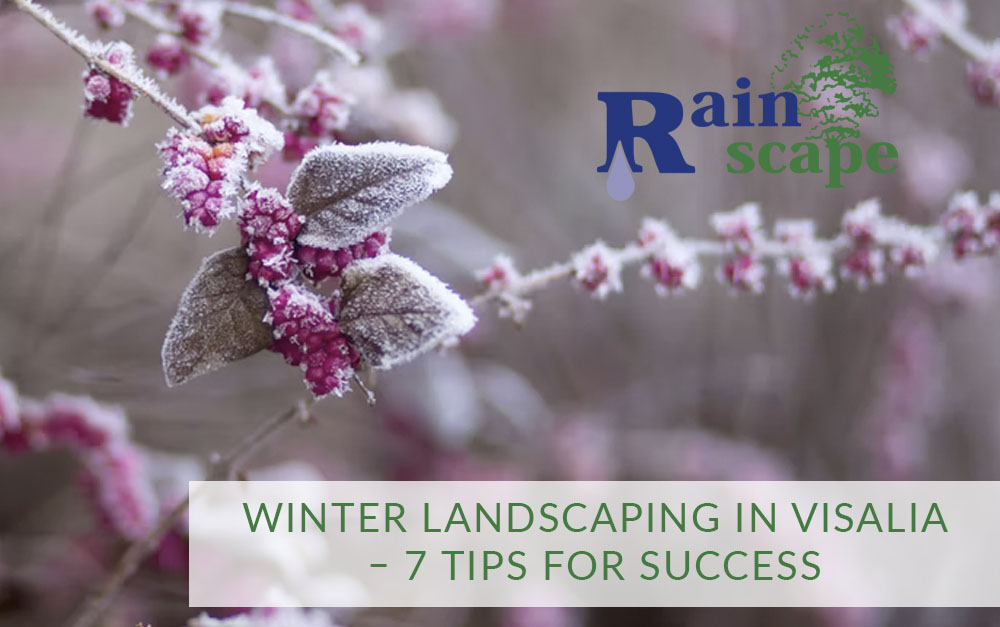Visalia isn’t known for the common images that come to mind when we think of winter landscaping. You won’t see the picturesque white snow blanketed scenery we all visualize from Hallmark holiday movies. Despite the lack of a snowy winter, unless you remember the rare snowfall in January of 1999, we still must adjust our gardening to the colder temperatures and increased precipitation. The increased precipitation will shock your vegetation if you don’t plan for it. The best way to attain success is through proper preparation and planning. If we prepare our landscapes now for the seasonal shift, we will see our dream vegetable and flower gardens flourish come spring.
These 7 tips and tricks will not only improve the exterior ambience of your home it will also set up your winter landscaping for optimal success.
- Prep your soil
A gardens foundation is its soil. If you are planning to amend or fertilize your soil, now is the time to get started. Educate yourself on your soils composition so that you are aware of what it needs to improve the overall structure. You can improve your soil’s physical properties, such as water infiltration, drainage, aeration, permeability, structure, and water retention. How can you improve them? You can add nutrients with compost and when necessary, fertilizers. When you do this, you will make sure your roots have the best environment possible to grow. To help prevent root suffocation, it’s important to aerate the soil.
- Add a winter blanket of mulch
The plant roots that are in the top few inches of soil are the most susceptible to the freeze-thaw patterns. A layer of mulch will add insulation and protection and serve as a warm incubator that improve your soils microbiome. Mulch also helps to prevent soil erosion during wind or rain and due to surface runoff. Weed growth is suppressed by mulch and it increases moisture retainment.
- Fix any drainage problems
It’s important to evaluate your drainage and make sure that your plants or lawn aren’t getting waterlogged. Make sure that the water moves in a way that is beneficial by taking the time to clean out your gutters and add fillers and drainage lines as needed. One option to improve drainage is to add drain rock to back fill perforated drainpipe and French drains and allow the water to flow in an intended direction.
- Plan your seeds
Some seeds can be sown in your garden during the transitional thaw period, also known as robin snow, but it’s best to get them started in closed, ventilated containers. The containers keep them safe from animals and more insulation for warmth. Check the expiration date on your seeds.
- Remove leaves and debris
Remove the dead plant matter and debris from your lawn to allow it to breathe and allow for adequate moisture without root rot. You will also reduce unwanted pests in your garden. The collected leaves and garden debris can be used as compost.
- Prune carefully
Take the time to prune dormant deciduous fruit trees, and trim hedges, shrubs, and trees. You will want to remove dead or decayed branches but be careful to avoid pruning frost-damaged plants. Damaged parts of the plant protect the plant during any future frosts.
- Select plants that will survive winter
If you’re not sure which plants to plant for your winter landscaping, choose native California plants. These plants that grow natively will have a better chance of survival during the shorter days. Spring annuals, summer bulbs, shrubs and root trees should be planted early during a thaw to allow them to ripen but be careful to not do it before a freeze or cold snap. Leafy greens, cauliflower, peas, cabbage, broccoli, and other plants will thrive during these months and keep the life in your garden.
The cooler weather makes the labor of gardening more enjoyable. The time you spend preparing and protecting your soil and warding off negative effects of frost will set up your garden for optimal success. If you have any questions, Rainscape Professionals would be happy to help! 559 651-2333

